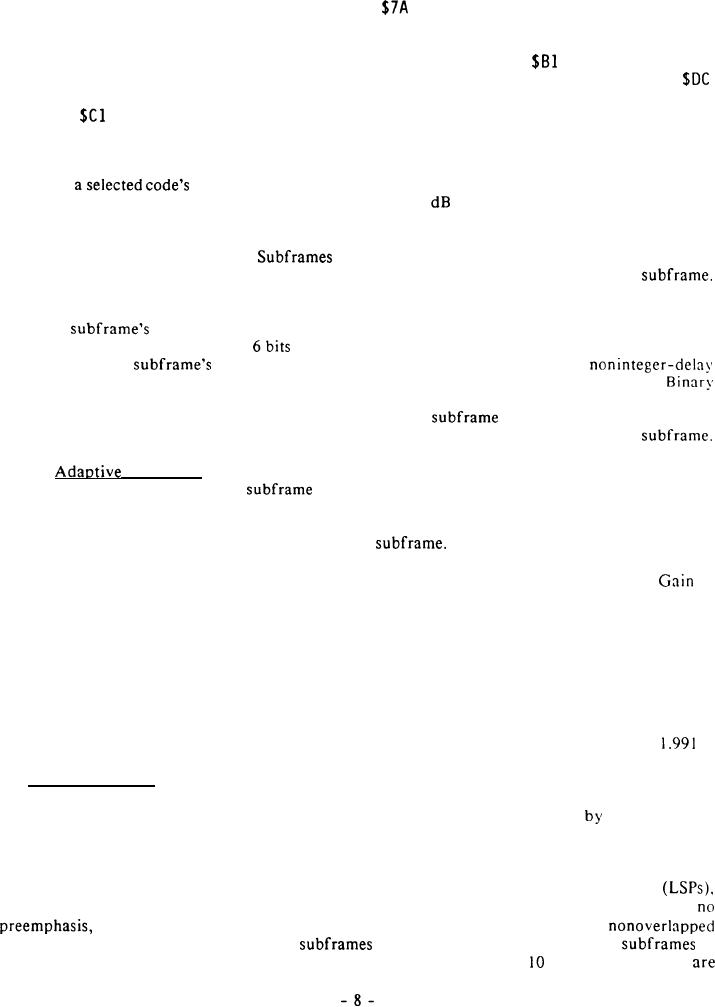
FED-STD 1016
140.0
$CF
32.25
$71
66.00
$68
89.00
$41
49.00 $ A D
141.0
$CE
66.33
$78
90.00
$A7
32.50
$6D
49.33 $95
142.0
$DE
66.67
91.00
$A3
32.75
$7D
49.67 $85
143.0
$BF
67.00
$7E
92.00
$B7
33.00
$69
50.00 $9D
144.0
$DF
67.33
$6A
93.00
$B3
33.25
$79
50.33 $8D
145.0 $ D D
33.50
$7B
50.67 $89
67.67
$6E
94.00
146.0
68.00
$6F
95.00
$B5
33.75
$7F
51.00 $99
147.0 $AF
34.00
$6B
51.33 $88
68.33
$C4
96.00
$A5
34.33
Note: Before an adaptive code is selected for transmission, consideration shouldbe
given to the possibility that amultiple of actual ''pitch'' is being selected. Submultiple
of
pitch equivalent should reexamined and maybe utilized instead
if results are found to be within approximately 0.5
ofa selected code's squared
prediction error.
for Transmission. The adaptive code selected for
3.5.5 Coding Within 2nd and 4th
transmissions representedin 6bits, based upon the adaptive code selected in the previous
Utilizing the table of adaptive codes in section 3.5.4, if aprevious subframe's adaptive code wasin
the range of20.00 - 29.25, the adaptive code tobe transmitted could run from 20.00 to 38.33. If the
previous
adaptive code was inthe rangeof 115.0- 147.0, the adaptive code could run
from 84.00 to 147,0. otherwise, the
will code the range from 31 codes lower to 32 codes higher
than the previous
adaptive code (considering both integer-delay and
adaptive codes). This is true even if an implementation uses only integer adaptive codes.
coding is such that the lowest numbered adaptive code is coded as 000000 and the highest numbered
adaptive code is coded as 111111. For example, for previous
adaptive codes between 29.50
and 114.0, binary 011111 indicates no difference from the adaptive code of the previous
3.6
Code Gain. The relative amplitude (to the nearest table value) to be applied to the
adaptive code elements of each
is determined during analysis and coded into 5 bits
according to the following table. The decimal index number is then transmitted in binary form. At
the receiver, in voice synthesis, the adaptive code gain index number is used to decode the relative
amplitude of the adaptive code elements during the
Index
Index
Index
Index
Gain
Gain
Gain
16
o
-.993
0.255
24
1.062
8
0.780
25
1
17
1.117
-.831
0.368
9
0.816
26
2
18
0.457
0.850
10
1.193
-.693
19
27
3
-.555
11
0.531
0.881
1.289
4
-.414
28
12
0.601
20
0.915
1.394
29
-.229
0.948
13
0.653
21
5
1.540
14
0.702
22
30
0.983
6
0.000
1.765
7
15
23
1.020
0.745
0.139
31
3.7 Linear Prediction
3.7.1 Linear Prediction Filter. A 10th order Linear Prediction Filter is excited
the sum of the
gain-adjusted "stochastic" and adaptive codes to synthesize voice.
3.7.2 Line Spectral Parameters. During voice analysis, the parameters of the Linear Prediction
Filter are determined and transmitted on a 30 ms frame basis as 10 Line Spectral Parameters
on the basis of 10th order linear prediction. It is recommended that LSPS be determined with
15 Hz bandwidth expansion (i.e., 0.994 weighting factor), and a 30 ms
Hamming window spanning the last two
of the present frame and first two
of
the next frame. Shown below is the coding to be employed for the
LSPS. Note: LSPS